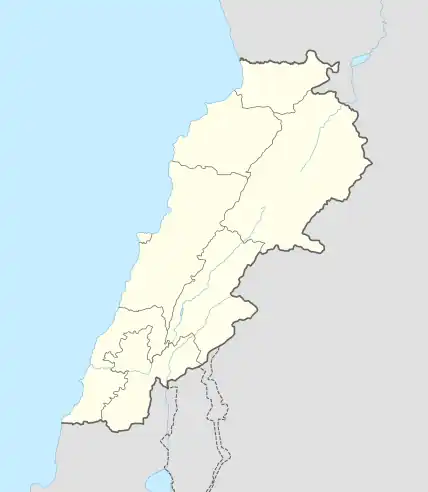Dekwaneh
دكوانة | |
|---|---|
City | |
 Dekwaneh Location within Lebanon | |
| Coordinates: 33°52′45″N 35°32′37″E / 33.87917°N 35.54361°E | |
| Country | |
| Governorate | Mount Lebanon Governorate |
| District | Matn District |
| Government | |
| • Time Zone | GMT +2 (UTC) |
| • - Summer (DST) | +3 (UTC) |
| • Area Code(s) | (+961) 1 |
| Time zone | UTC+2 (EET) |
| • Summer (DST) | UTC+3 (EEST) |
| Dialing code | +961 |
Dekwaneh (or Dekweneh; Arabic: دكوانة) is a suburb north of Beirut in the Matn District of the Mount Lebanon Governorate, Lebanon. The population is predominantly Maronite Christian.[1] Tel al-Zaatar, an UNRWA administered Palestinian refugee camp housing approximately 50,000-60,000 refugees, and the site of the Tel al-Zaatar massacre were located on the outskirts of the town.[2]
Archaeology
Dekwaneh I is about 700 metres (2,300 ft) northwest of Mar Roucos monastery, in the gullies of (now deforested) pinewood slopes on the west side of a ridge. Material was found by Raoul Describes, who mentioned rock-shelters in the area that were destroyed by quarrying for quicklime.[3] Further collections were found by Auguste Bergy and Peter Wescombe. Some of the flint tools recovered were determined to be Acheulean as well as a large amount of waste and bifaces from the Middle Paleolithic that suggested it was a factory site at that time.[4]
Dekwaneh II material comes from various locations around the area, most notably the ravine below the monastery. Flint tools were also found here by Bergy and Describes which included the Qaraoun culture's Heavy Neolithic forms such as massive axes, picks, scrapers and rabots. Other early Neolithic tools were found along with some Middle Paleolithic material including an Emireh point and tortoise cores. Along with material from Dekwaneh I, finds from the locations are stored in the Museum of Lebanese Prehistory.[4]
LGBT rights
Dekwaneh gained notoriety in the press and social media when, on Monday 22 April 2013, the mayor, Antoine Chakhtoura, ordered Lebanese security forces to raid and shut down a gay-friendly nightclub called Ghost.[5] A number of Syrian gay men and a Lebanese transgender woman were arrested during the raid and taken to municipal headquarters where it is reported that they were harassed and forced to undress. According to reports, the transgender woman was also photographed naked.[6][7]
Image gallery
 General Elias Wessin (Wazen) Street in Dekwaneh, Lebanon.
General Elias Wessin (Wazen) Street in Dekwaneh, Lebanon. St. Joseph chapel
St. Joseph chapel Statue of the Immaculate Conception
Statue of the Immaculate Conception
Airfield
Remains of a former airfield can be found in Tal El Zaatar. Only a small section of runway exist with Northern section along Mar Roukoz has been reused for commercial warehouses.
References
- ↑ Samir Khalaf (2002). Civil and uncivil violence in Lebanon: a history of the internationalization of communal conflict. Columbia University Press. pp. 222–. ISBN 978-0-231-12477-5. Retrieved 13 August 2011.
- ↑ P. Edward Haley; Lewis W. Snider; M. Graeme Bannerman (1979). Lebanon in crisis: participants and issues. Syracuse University Press. pp. 26–. ISBN 978-0-8156-2210-9. Retrieved 13 August 2011.
- ↑ Describes, Raoul., Quelques ateliers paléolithiques des environs de Beyrouth, Mélanges de l'Université Saint-Joseph: Volume VII, 1921.
- 1 2 Lorraine Copeland; P. Wescombe (1965). Inventory of Stone-Age sites in Lebanon, p. 85. Imprimerie Catholique. Retrieved 21 July 2011.
- ↑ "Mayor of Dekwaneh forces gay residents to strip naked and be photographed". Lebanon News. 24 April 2013. Retrieved 2 May 2013.
- ↑ "Transgender victim speaks out on being sexually abused by Lebanese officials". YaLIbnan. 26 April 2013. Retrieved 2 May 2013.
- ↑ Al-Akhbar (23 April 2013). "Lebanese mayor cracks down on homosexuality in his town". Al-Akhbar. Retrieved 2 May 2013.
External links
- Dekwaneh - Deir Mar Roukoz - Dahr El Hossein, Localiban
